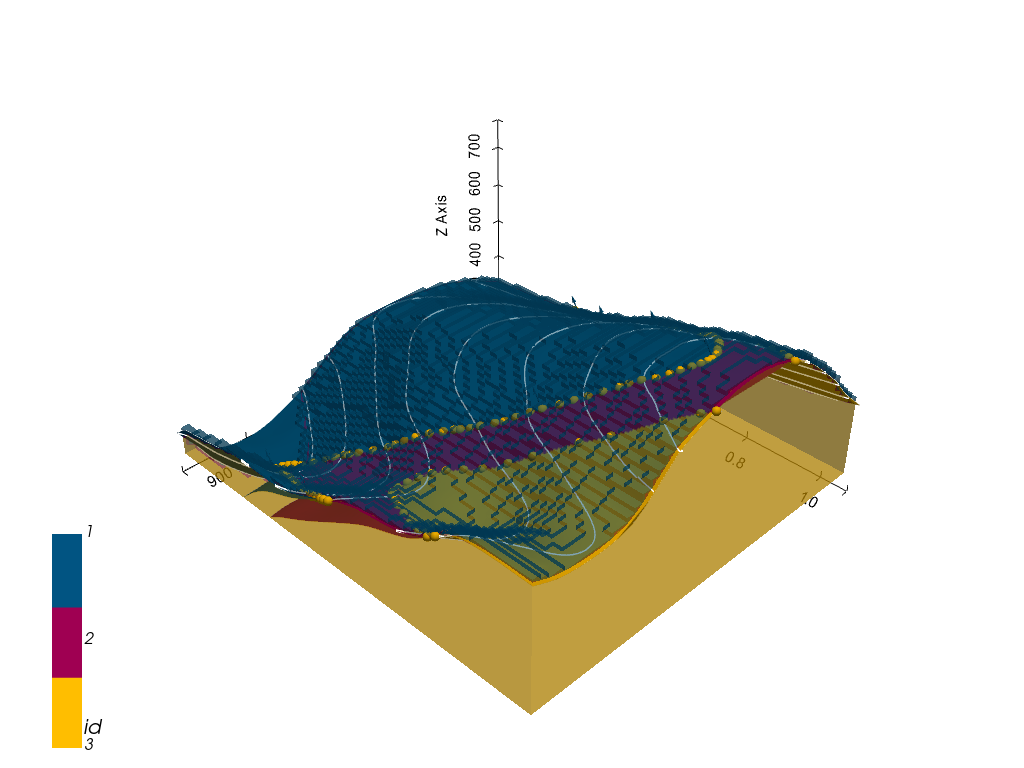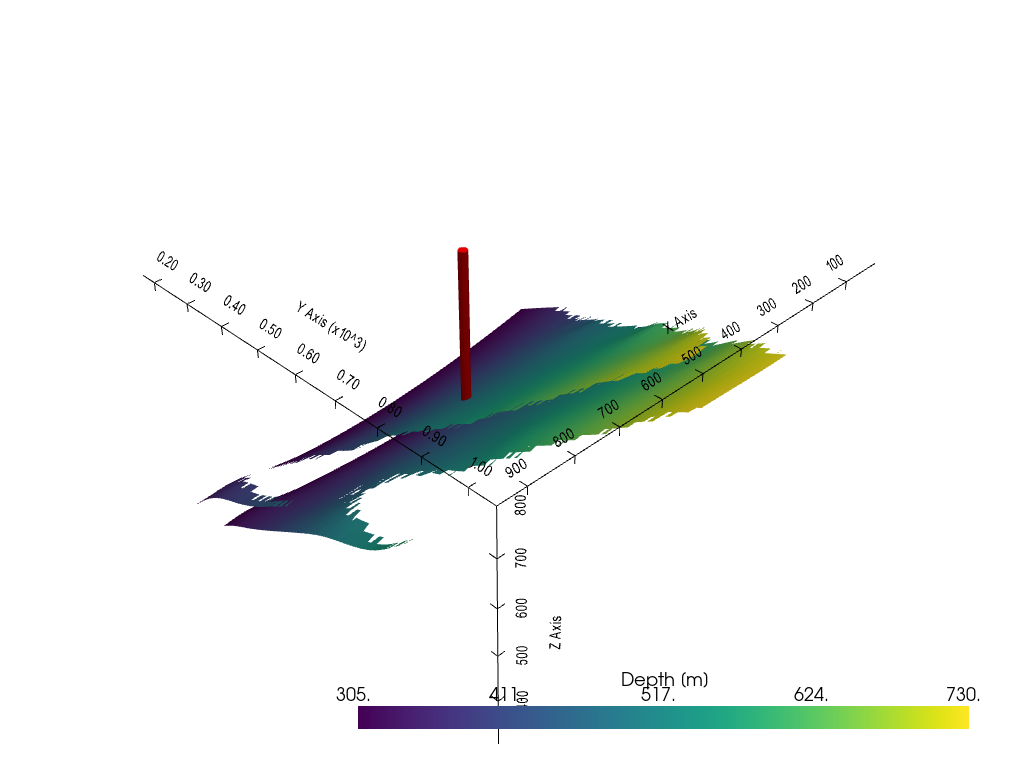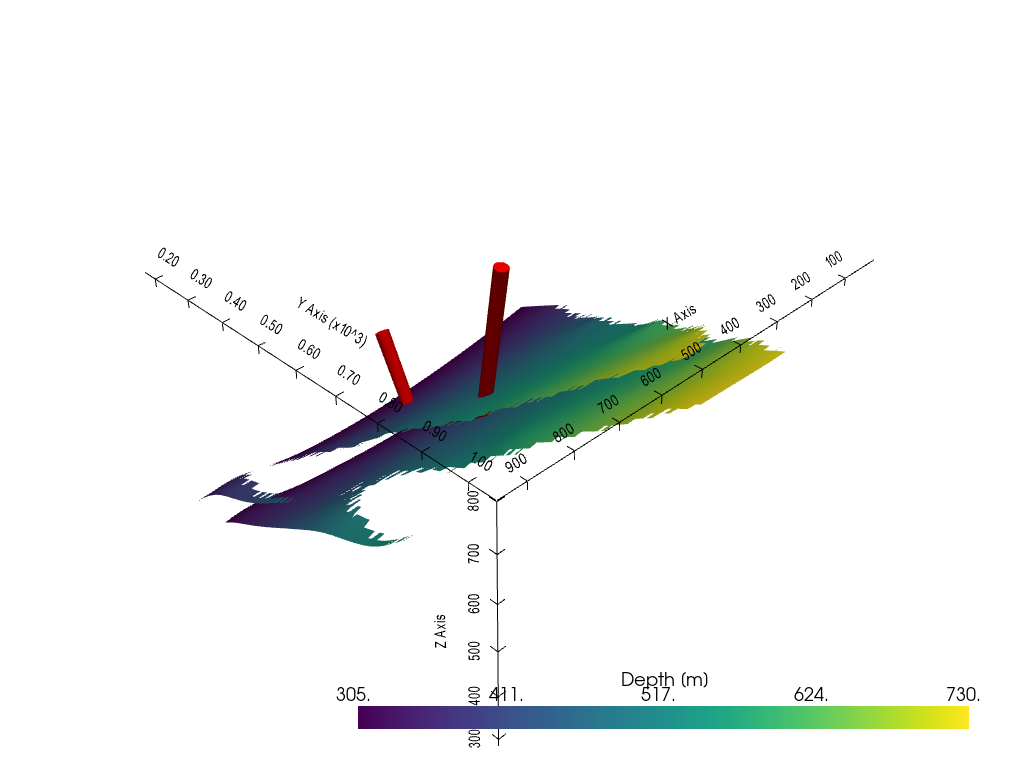55 Extracting Well Tops from PyVista Meshes
Contents
55 Extracting Well Tops from PyVista Meshes#
The following notebook illustrates how to extract well tops or in the case of GemPy well bases from PyVista meshes of GemPy models. In particular, a ray tracing algorithm in PyVista is used to extract the intersections of a borehole (PyVista Polydata) with a PyVista mesh. Straight boreholes as well as deviated boreholes can be used.

Set File Paths and download Tutorial Data#
If you downloaded the latest GemGIS version from the Github repository, append the path so that the package can be imported successfully. Otherwise, it is recommended to install GemGIS via pip install gemgis and import GemGIS using import gemgis as gg. In addition, the file path to the folder where the data is being stored is set. The tutorial data is downloaded using Pooch (https://www.fatiando.org/pooch/latest/index.html) and stored in the specified folder. Use
pip install pooch if Pooch is not installed on your system yet.
[1]:
import warnings
warnings.filterwarnings("ignore")
import gemgis as gg
import geopandas as gpd
import rasterio
import gempy as gp
import pyvista as pv
import matplotlib.pyplot as plt
import numpy as np
import pandas as pd
WARNING (theano.configdefaults): g++ not available, if using conda: `conda install m2w64-toolchain`
WARNING (theano.configdefaults): g++ not detected ! Theano will be unable to execute optimized C-implementations (for both CPU and GPU) and will default to Python implementations. Performance will be severely degraded. To remove this warning, set Theano flags cxx to an empty string.
WARNING (theano.tensor.blas): Using NumPy C-API based implementation for BLAS functions.
[2]:
file_path ='data/55_extracting_well_tops_from_pyvista_meshes/'
gg.download_gemgis_data.download_tutorial_data(filename="55_extracting_well_tops_from_pyvista_meshes.zip", dirpath=file_path)
Creating GemPy Model#
Loading Topography#
[3]:
topo_raster = rasterio.open(file_path + 'raster1.tif')
Creating Interfaces#
[4]:
interfaces = gpd.read_file(file_path + 'interfaces1_lines.shp')
interfaces_coords = gg.vector.extract_xyz(gdf=interfaces, dem=topo_raster)
interfaces_coords.head()
[4]:
| formation | geometry | X | Y | Z | |
|---|---|---|---|---|---|
| 0 | Sand1 | POINT (0.256 264.862) | 0.26 | 264.86 | 353.97 |
| 1 | Sand1 | POINT (10.593 276.734) | 10.59 | 276.73 | 359.04 |
| 2 | Sand1 | POINT (17.135 289.090) | 17.13 | 289.09 | 364.28 |
| 3 | Sand1 | POINT (19.150 293.313) | 19.15 | 293.31 | 364.99 |
| 4 | Sand1 | POINT (27.795 310.572) | 27.80 | 310.57 | 372.81 |
Creating Orientations#
[5]:
orientations = gpd.read_file(file_path + 'orientations1.shp')
orientations = gg.vector.extract_xyz(gdf=orientations, dem=topo_raster)
orientations['polarity'] = 1
orientations
[5]:
| formation | dip | azimuth | geometry | X | Y | Z | polarity | |
|---|---|---|---|---|---|---|---|---|
| 0 | Ton | 30.50 | 180.00 | POINT (96.471 451.564) | 96.47 | 451.56 | 440.59 | 1 |
| 1 | Ton | 30.50 | 180.00 | POINT (172.761 661.877) | 172.76 | 661.88 | 556.38 | 1 |
| 2 | Ton | 30.50 | 180.00 | POINT (383.074 957.758) | 383.07 | 957.76 | 729.02 | 1 |
| 3 | Ton | 30.50 | 180.00 | POINT (592.356 722.702) | 592.36 | 722.70 | 601.55 | 1 |
| 4 | Ton | 30.50 | 180.00 | POINT (766.586 348.469) | 766.59 | 348.47 | 378.63 | 1 |
| 5 | Ton | 30.50 | 180.00 | POINT (843.907 167.023) | 843.91 | 167.02 | 282.61 | 1 |
| 6 | Ton | 30.50 | 180.00 | POINT (941.846 428.883) | 941.85 | 428.88 | 423.45 | 1 |
| 7 | Ton | 30.50 | 180.00 | POINT (22.142 299.553) | 22.14 | 299.55 | 368.05 | 1 |
Calculating GemPy Model#
[6]:
geo_model = gp.create_model('Model1')
gp.init_data(geo_model, [0, 972, 0, 1069, 300, 800], [50, 50, 50],
surface_points_df=interfaces_coords,
orientations_df=orientations,
default_values=True)
gp.map_stack_to_surfaces(geo_model,
{'Strata': ('Sand1', 'Ton')},
remove_unused_series=True)
geo_model.add_surfaces('Basement')
geo_model.set_topography(source='gdal', filepath=file_path + 'raster1.tif')
gp.set_interpolator(geo_model,
compile_theano=True,
theano_optimizer='fast_compile',
verbose=[],
update_kriging=False
)
sol = gp.compute_model(geo_model, compute_mesh=True)
Active grids: ['regular']
Cropped raster to geo_model.grid.extent.
depending on the size of the raster, this can take a while...
storing converted file...
Active grids: ['regular' 'topography']
Compiling theano function...
Level of Optimization: fast_compile
Device: cpu
Precision: float64
Number of faults: 0
Compilation Done!
Kriging values:
values
range 1528.9
$C_o$ 55655.83
drift equations [3]
[7]:
gpv = gp.plot_3d(geo_model,
image=False,
show_topography=True,
plotter_type='basic',
notebook=True,
show_lith=True,
show_boundaries=True)

Extracting Surfaces from the GemPy Model#
[8]:
mesh = gg.visualization.create_depth_maps_from_gempy(geo_model=geo_model, surfaces=['Sand1', 'Ton'])
mesh
[8]:
{'Sand1': [PolyData (0x1e4a0b2b3a0)
N Cells: 4209
N Points: 2325
X Bounds: 9.720e+00, 9.623e+02
Y Bounds: 1.672e+02, 9.497e+02
Z Bounds: 3.050e+02, 7.250e+02
N Arrays: 1,
'#015482'],
'Ton': [PolyData (0x1e49c0c30a0)
N Cells: 5396
N Points: 2891
X Bounds: 9.720e+00, 9.623e+02
Y Bounds: 2.799e+02, 1.058e+03
Z Bounds: 3.050e+02, 7.297e+02
N Arrays: 1,
'#9f0052']}
Extracting intersections between boreholes and meshes#
First, a PolyData set is created and visualized. The first attempt shows a straight vertical well.
[9]:
well = pv.Line((500,500, 800), (500, 500, 300))
well_tube = well.tube(radius=10)
well_tube
[9]:
| Header | Data Arrays | ||||||||||||||||||||||||||||||||||||||
|---|---|---|---|---|---|---|---|---|---|---|---|---|---|---|---|---|---|---|---|---|---|---|---|---|---|---|---|---|---|---|---|---|---|---|---|---|---|---|---|
|
|
[10]:
p = pv.Plotter(notebook=True)
p.add_mesh(mesh['Sand1'][0], scalars = 'Depth [m]')
p.add_mesh(mesh['Ton'][0], scalars = 'Depth [m]')
p.add_mesh(well_tube, color='red')
p.show_bounds()
p.show()

[12]:
gg.utils.ray_trace_one_surface(mesh['Sand1'][0],
well.points[0],
well.points[1])
[12]:
(array([[500. , 500. , 465.47574]], dtype=float32), array([2895]))
[13]:
gg.utils.ray_trace_multiple_surfaces([mesh['Sand1'][0], mesh['Ton'][0]],
well.points[0],
well.points[1])
[13]:
[(array([[500. , 500. , 465.47574]], dtype=float32), array([2895])),
(array([[500. , 500. , 408.50534]], dtype=float32), array([3181]))]
[14]:
gg.utils.create_virtual_profile(names_surfaces=list(mesh.keys()),
surfaces=[mesh['Sand1'][0], mesh['Ton'][0]],
borehole=well)
[14]:
| Surface | Z | |
|---|---|---|
| 0 | Sand1 | 465.48 |
| 1 | Ton | 408.51 |
The second test will be made with a not so much realistic well path but to illustrate that also deviated boreholes work to extract the intersections. Here, we define a well with three segments (four points).
[15]:
points = np.array(((500,600, 800),
(500, 550, 460),
(500, 350, 300),
(500, 250, 500)))
polyline = polyline_from_points(points)
tube = polyline.tube(radius=15)
polyline
[15]:
| Header | Data Arrays | ||||||||||||||||||||||||||
|---|---|---|---|---|---|---|---|---|---|---|---|---|---|---|---|---|---|---|---|---|---|---|---|---|---|---|---|
|
|
[16]:
p = pv.Plotter(notebook=True)
p.add_mesh(mesh['Sand1'][0], scalars = 'Depth [m]')
p.add_mesh(mesh['Ton'][0], scalars = 'Depth [m]')
p.add_mesh(tube, color='red')
p.show_bounds()
p.show()

[17]:
gg.utils.create_virtual_profile(names_surfaces=list(mesh.keys()),
surfaces=[mesh['Sand1'][0], mesh['Ton'][0]],
borehole=polyline)
[17]:
| Surface | Z | |
|---|---|---|
| 0 | Sand1 | 497.21 |
| 1 | Ton | 377.33 |
| 2 | Sand1 | 357.01 |
| 3 | Ton | 313.96 |
[ ]:
